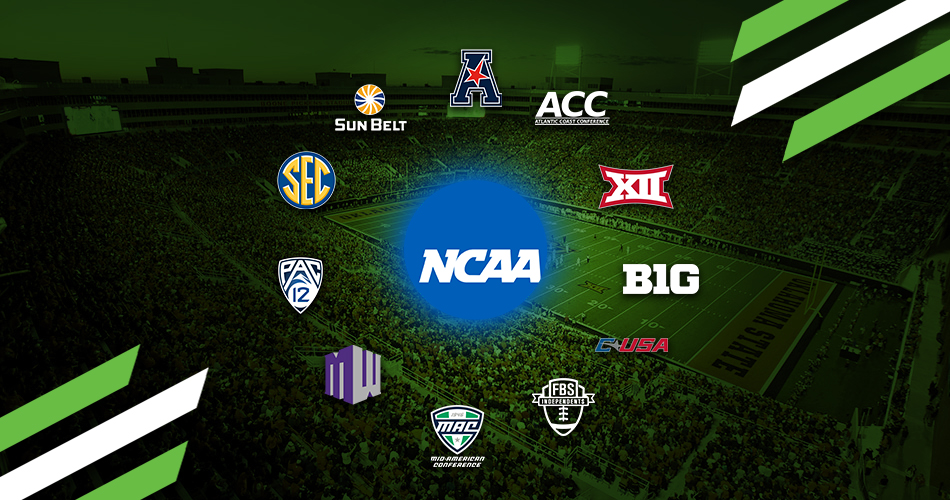College Football Betting Tips
Trying to explain college football to the uninitiated often produces more questions than answers. Why do people support so passionately for teams that represent schools they never attended? Why are there 12 teams in the Big 10 and 10 teams in the Big XII? What the hell is a Hokie?
The fact of the matter is, very little about college football makes a whole lot of sense. But in an effort to make seance of the chaos, we have selected four frequently asked questions to answer as a beginner’s guide to America’s second-favourite sport.
What constitutes major college football?
There are four levels of college football in the National Collegiate Athletic Association (NCAA), but the one that really matters is the Football Bowl Subdivision (FBS). If you’re scoring at home, the other three levels are the Football Championship Subdivision (FCS), Division II and Division III.
There are 124 teams in the FBS, divided into 11 conferences – Notre Dame, Brigham Young University, Army and Navy are the only four schools in the FBS that are not affiliated with a conference. Six of those 11 leagues – the Southeastern Conference, the Big XII, the Big 10, the Pac-12, the Big East, and the Atlantic Coast Conference – are considered to be major.
The Southeastern Conference or SEC is comprised largely of public institutions in the former confederacy. It has earned the reputation as being the best football conference in the country, by virtue of having a member institution win the national championship in each of the last six seasons.
The Big XII is based primarily in the Great Plains states and Texas – the Sooners of Oklahoma and the Longhorns of Texas are its traditional powers. The league, although still a power, has lost four members in the last two years to other conferences, while adding only two schools, thus the discrepancy between the conference’s name and membership.
The Big 10, the nation’s oldest conference, features mostly large land-grant institutions from the upper Midwest, with Ohio State, Michigan, Nebraska, and Penn State representing the top programs. Having been known as the Big 10 since 1917, the conference kept the name despite adding Penn State in 1993 and Nebraska in 2011.
The Pac-12 is made up of schools from the Pacific coast and Rocky Mountain regions Southern Cal, Oregon and Stanford lead the way. The Atlantic Coast Conference (ACC) stretches from Boston College in the north to Miami in the south, with Miami, Virginia Tech and Florida State taking top honours. Finally, the Big East – which will soon feature teams as far-flung as San Diego – used to be the home of the major college programs along the eastern seaboard. Recent defections have made it a major conference in name only.
No school from outside of these six conferences has ever played for the national championship in the Bowl Championship Series era, which began in 1998 when these six conferences and Notre Dame formed an alliance, in order to produce a true national champion.
I know, it’s a lot to take in!
How is a champion determined?
The goal for every team is to finish the regular season either first or second in the Bowl Championship Series (BCS) rankings and therefore be selected to play in the BCS National Championship Game.
Stay with me now…
During the regular season, teams play the majority of their games against other members of their conferences (The Big XII and Pac-12 play nine conference games per season while the ACC, SEC and Big 10 play eight. Teams in the Big East, which has only eight football-playing members, can only play seven games against their league foes.)
At the end of each regular season, a conference champion is crowned. In the case of the Pac-12, Big 10, SEC, and ACC, the champion is determined in a winner-take-all league championship game. The Big XII and Big East championships are awarded to the team with the best record in regular season intra-conference match-ups.
The six conference champions, plus four additional teams selected primarily, but not exclusively, from the six major leagues, are invited to participate in the five BCS bowl games, which include the Orange Bowl in Miami, the Fiesta Bowl in the Phoenix area, the Sugar Bowl in New Orleans, the Rose Bowl in Pasadena and the BCS National Championship Game, which is played in one of the four sites of the other major bowl games, on a rotating basis. The top two teams according to the BCS rankings are invited to play in the BCS Championship game, with the winner being named the BCS champion.
The BCS rankings rely on human polls as well as a computer algorithm to determine the top two teams in the country. The best way to earn a spot in the title contest is to be a member of one of the six major conferences and win all of your regular season games, although in seven of the 14 years that this system has been in place, at least one of the teams playing in the title game has entered the contest with at least one loss and twice a team from a major conference gone undefeated during the regular season but has not been invited to play for the championship – Auburn of the SEC in 2004 and Cincinnati of the Big East in 2009.
How and why are teams ranked before the season even begins?
Prior to the season, polls are taken of select FBS coaches and media members who cover the sport, asking them to rank who they believe will be the top teams in the country during the upcoming campaign. These speculative rankings are based largely on how a team performed the previous year, the level of talent returning to the side for the upcoming season and the quality of incoming players.
Each week during the season, the pollsters are asked to re-rank the teams in order, taking into account the results from the previous week. A team that is ranked and wins usually either maintains its position or moves up as a result of a squad that was ranked higher losing.
But the rankings are not scientific. Rather they are based on the opinions of the pollsters. The computer algorithm used to help determine which two teams play for the national championship does not factor into the two human polls. This means that though Alabama – currently the top-ranked side in both the media and coaches polls – is considered to be the best team in the country, this is more a matter of opinion than it is of fact.
However, since the polls are part of the formula that is used to determine who plays for the national championship, these rankings are critically important.
In 2005 the media poll, known as the Associated Press poll, was removed from the formula used to determine the top two teams in the country. A new poll, the Harris Interactive poll – comprised of former players, coaches, college administrators and non-AP journalists, – was concocted the following year to replace the AP Poll. Traditionally, the polls have the same teams ranked in pretty much the same spots as the season progresses.
What’s the deal with all these bowl games?
For the most part, all FBS teams that finish the regular season with at least six wins are eligible to participate in a postseason bowl game. There are 35 such contests, but outside the BCS National Championship game, none has any bearing on identifying the national champion. Rather, an invitation to a bowl game is seen largely as a reward for a team that has had a successful season, a feather in the cap of the coach of such a side and a chance for a sizeable payday for the participating schools – although the value of these payouts has been questioned in recent years.
We are almost there!
Each bowl game is an independent entity, and match-ups are determined primarily by conference affiliation. For example, the Big 10 has deals in place with eight bowl games, so if eight of the league’s 12 teams finish with six wins or more, they will play in one of those contests. However, the emergence of the BCS National Championship game and the proliferation of bowl games – in 1998, when the BCS began, there were only 23; 35 were played last year – have greatly diminished the prestige of such contests.
Now for the important part, the betting side of things.
Best College Football Betting Markets
There is no shortage of places to bet when it comes to the College Football, with all major bookmakers providing you with no end of markets to get stuck into, whether it be a 1st touchdown, winning margin and everything in-between you should not have any problem of finding a bet that suits your needs.
The following is a list of some of the bookmakers that provide College Football markets.
* Click here for the best Betway odds and offers.
* Click here for the best Coral odds and offers.
* Click here for the best Ladbroke odds and offers
Point Spreads
Point Spreads, also known as lines, spreads or sides these are the most common bets. Each game has a favourite which will be determined by a – sign and an underdog which will have a + sign. For example, if Notre Dame were -7.5 favourites against Iowa State +7.5 underdogs, if you were to wager on the spread for Notre Dame they will need to win by 8 points. If you choose Iowa you can lose by 7 or win. It is basically a handicap bet.
Money Lines
This is simply betting on an outright winner of a particular game. Wagering on the favourite will require more money to make some profit while wagering on the underdog will have a great reward if it wins.
Totals
Also known as over/under and these are nearly as popular as the spread. A bookmaker will decide a number for total points in the game and you wagering over or under i.e. Over 45.5/Under 45.5
Props
Bets on how certain players will behave or play in a certain game i.e. first TD scorer, anytime TD Scorer etc.
Conclusion
The unpredictability of the NFL brings a season full of excitement, upsets and drama. The College Football betting experts at BetOpin provide you with the best tips to get you in the end zone of all the top bookmakers.












